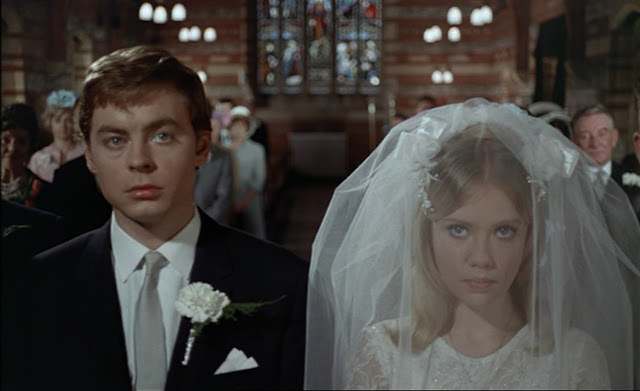Family Way (1966)
 |
| Hywel Bennett & Hayley Mills |
Back in the early 1980s I bought a book entitled something like 'The Fifty Greatest British Films'. This was included among them. Be warned, I doubt if it would even get into a list of the fifty greatest British films of the 1960s ... I'm not even sure it would get into a list of the fifty greatest British films of 1966 ... that were filmed in Bolton. It's not thought provoking and it's not funny. It's not hard hitting or engagingly lightweight: It's dull.
The story of a newly married couple (Hywel Bennett and Hayley Mills) whose marriage isn't consummated, due to his failure to 'perform'. This leads to his being humiliated when the whole town finds out. The trouble is, I didn't really care. The circumstances leading to his troubles (he's a sensitive soul, we know that because he listens to classical music) aren't very engaging. Also, this is the 1960s - the age of the pill, the permissive society and all that old stuff that social commentators like to go about. Can't we have an open look at sex in working class British communities? The presentation of sexual issues was actually more hard hitting in 'Love on the Dole' (1941).
Ah, did I say 'Love on the Dole'? There's a connection: both are about the sex lives of working class youngsters in the industrial north and both feature Marjorie Rhodes ...
... who appears here Hywel Bennett's mother. Twenty-five years earlier she had appeared as Mrs Bull, one of a quartet of ladies who act as the 'Greek Chorus' ("a homogeneous, non-individualised group of performers, who comment with a collective voice on the dramatic action") in that film.
In 'Family Way' there is also a group of four women who perform the same function ...
... one of whom is a Mrs Bell. Coincidence? Maybe.
Here's who else to look out for (if you can be bothered):
 |
| John Mills |
 |
| Barry Foster |
 |
| John Comer |
 |
| Avril Angers |
 |
| Kathy Staff (right) |
 |
| Liz Fraser |
 |
| Thorley Walters |
 |
| Murray Head |
 |
| Russell Walters |
 |
| Windsor Davies |
Oh, P.S. ...
Hayley Mills shows the audience her bum ...
... if you like that sort of thing.










































